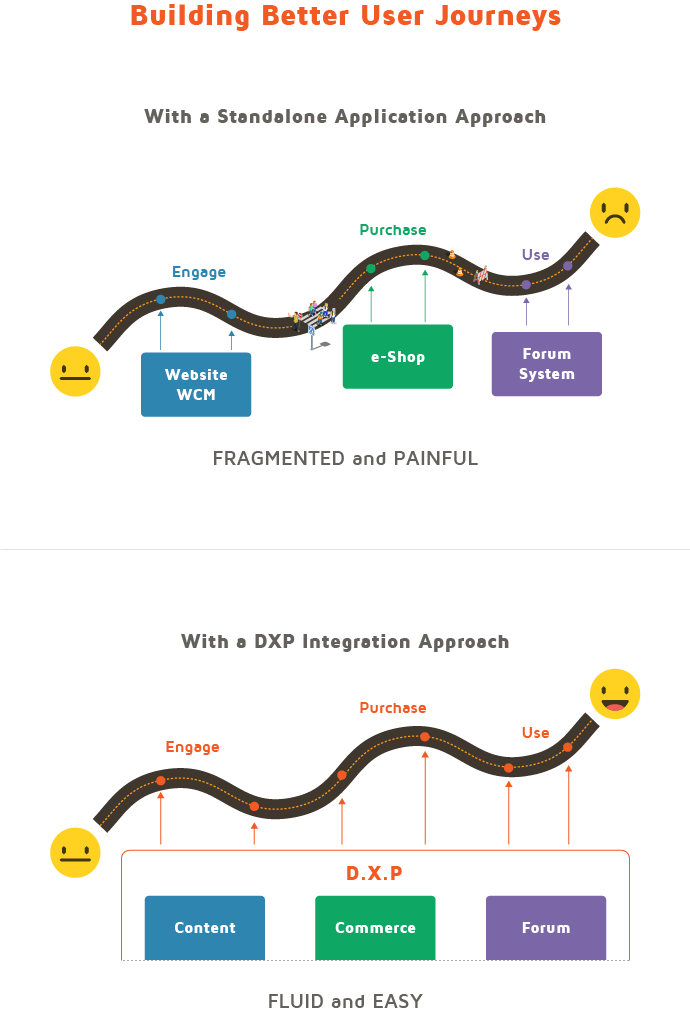What is a Digital Experience Platform (DXP) compared to a Content Management System (CMS)?

What is a Digital Experience Platform? Will DXP replace CMS?
No doubt you are familiar with CMS (Content Management Systems), indeed you may have been through a couple of implementations of different Content Management Systems in your organization. In all likelihood, you will have gone through a first-generation CMS in the early or mid-2000s when WCM (Web Content Management) solutions and CMS began to cater for organizations and businesses to publish content online.
Then came Web 2.0 and smartphones - websites evolved, no longer remaining as static brochureware. Also, around this time social media burst onto the scene, CMS vendors adapted, and new functionalities were developed, progressively developing the next generation of CMS in the mid-2010s, very often based on Open-Source technology.
As companies have undergone digital transformation so a third generation of systems have emerged, the DXP (Digital Experience Platform). Having been bombarded with this new acronym by software vendors, media, digital agencies and peers you may feel rather confused, not to mention other variations along the lines of WEM, DEM, CXM and so on.
Don't panic. Read on.
Designed to provide better customer experiences, DXPs are the natural evolution of your good old (or not so old) CMS, simply with much more functionality and seamless integrations giving you a new perspective in a world that has now fully pivoted to be customer-centric on all fronts.
It's First and Foremost About Building "Your" Digital Experience Platform
DXP is now promoted by CMS vendors like eZ, as an umbrella term for a range of capabilities in their software stack that are complementary to each other. It is all about building digital experiences: content creation, content delivery, e-commerce, personalization, analytics and more. I should emphasize that what is ultimately at stake is not the "vendor" software platform itself but the "customer" business platform. It is much more than a piece of software, it's the combination of an organization, its culture, strategy, people and of course, the technology platform that enables the organization to succeed with its digital business. Technology by itself is unable to solve the need.
The ultimate goal is to help every organization to build their own platform that will allow them to create, operate, maintain, govern and grow their digital operations. In other words, a platform that enables you to create and deliver the most effective digital experiences delighting your customers (or users) all along every step of their journey with you, from very early engagement to as long as you want to take it.
Such a platform will never be the result of an "off-the-shelf" purchase based on a single all-in-one product of a single vendor.
Forrester has long believed that despite vendors selling increasingly large chunks of digital experience platforms, enterprises don't buy everything from one vendor. Buyers should look for vendors that support an architectural approach to building a digital experience platform stack in three layers:
- Experience management and delivery give practitioners contextual control
- Platform services act as a force multiplier to accelerate operational agility
- Infrastructure services anchor the operations, security, and development.
Read in detail in the Forrester Wave: Digital Experience Platforms, Q3, 2019.
What Makes a Good Digital Experience Platform? Put the User First
A good digital experience platform for a company is when the organizational and technological setup enables the organization to deliver outstanding experiences to its customers. A digital experience that is smooth, easy, memorable and enjoyable, at all customer touchpoints all their journey with the organization, from the initial interaction to the latest one when he has become a loyal customer and enthusiastic advocate of the brand.
It's all about being able to build superior digital experiences that will give you a competitive advantage to build your edge and your market. You should be able to do this with speed, and repeatedly, by always improving user experiences and taking them to new heights.
Naturally there are many other important considerations such as TCO, ease of use, ease to operate and maintain, resilience and the ability to evolve…but the consideration of perfecting the customer experience should be uppermost.
What Does it Take to Deliver These Digital Experiences?
So exactly what are digital experiences? They are made of the sum of all digital touchpoints or interactions between you and your customers at every stage of the customer journey. This might include touchpoints on your websites, on apps, on other channels such as social media, digital signals or whatever interactive connected device we can think of.
So, when it comes to selecting the technology platform, it's patently obvious that to deliver the above, one thing is crucial: a technology stack that orchestrates and delivers all these digital touchpoints, across multiple channels.
And for it to work well, it's a good idea to think of using a single technology layer to support all digital touchpoints, instead of several solutions (e.g. one global platform instead of one web CMS for editorial, one e-Commerce engine for the shopping part and one forum/ community software for online support).
It is important to note that there is a big difference between a single technology to manage the experience and an all-in-one approach. In the first, the interaction layer should be unique to ensure good user experience, but it should not deliver all features by any means, but connect to other systems.
In reality, this is not so new. It is not much different from how modern CMS solutions have evolved. CMS vendors have long understood that they had to offer solutions that would do much more than purely managing and delivering content on pages. They have developed additional functionalities for example, to purchase products online, or to access services on these websites. Also, vendors have created communities where partners, independent developers and designers build and share add-ons and services, extending far beyond the scope of traditional content management.
Today CMS solutions are commonly regarded as development platforms rather than merely business applications in themselves. Yet reality shows that this is can be a bit of a stretch. Some CMS solutions have been found to be lacking when it comes to managing some critical sets of capabilities. I am thinking here about domains such as advanced personalization across sites and devices, e-Commerce capabilities and integration with business systems such as ERP, CRM and DMPs which are typically separate technologies with which organizations have had to integrate their CMS solutions.
As CMS solutions extended beyond their initial mandate, vendors like eZ started to invest in capabilities that would deliver on the above goals, and the market realized the moniker 'CMS' was no longer the right fit, at least if for those solutions that do more besides pure content management.
Some CMS solutions have evolved into what we mean today by DXP. This term, which has now been adopted for a few years refers to technologies that do differ from CMS. I'll dig a little deeper into explaining the differences.
Where Do We Draw the Line Between CMS and DXP?
Traditional CMS solutions cover a very well-defined set of functional requirements. You may find different 'flavors' of CMS, but overall the functionalities are similar across the board. To make it short, things such as: content creation, content curation, the import and export of content, content delivery on web pages and web sites, optionally via APIs, editorial workflow management, and design and layout management. All the other things that modern CMS vendor added go beyond the original mandate of the CMS.
Today, a CMS is not enough. It takes much more to deliver on our customers' needs, and that is this "much more" that we expect from a DXP
When it comes to a DXP there is no such well-defined functional scope. However, one thing is for sure: a DXP is more than a CMS. It has to include CMS capabilities but must offer more, and must follow a different approach. For example, one DXP might have out-of-the-box advanced e-Commerce, while another won't. The same goes for out-of-the-box behavioral personalization capabilities or integrated analytics. But what commonality they all to have is to provide the organization with a core foundational technology and the ability to integrate it with complementary set of technologies to let the business build its digital platform.
In other words, bringing back the very often discussed "solution vs platform" rhetoric, a CMS is much more of a 'Solution' for content workers while a DXP can be considered a 'Platform' for digital builders (content strategists, information architects, service designers, interaction designers and of course, developers).
The Core Technology Components of a DXP
At eZ, we have a clear vision regarding the core functional components a DXP should provide so that enterprises can focus on business-specific development.
According to Gartner Peer Insights review website: "Gartner defines a digital experience platform (DXP) as an integrated set of technologies, based on a common platform, that provides a broad range of audiences with consistent, secure and personalized access to information and applications across many digital touchpoints."
Content Hub
Almost all digital interactions happen through content. Whether it's engaging to discover solutions or services, purchasing a product, engaging with the brand and its stories, interacting with a bot, using support or online self-service, commenting etc. It is key to be able to create, organize and manage the content that will fuel your digital experiences. This includes the technical capability to provide access to content to any systems through APIs. As building distributed applications has become more and more a common design pattern, having the ability to deliver this content like a "headless CMS" is very important here, although not the only mode of delivery required.
Site and App builder
Content is powerful, but content is nothing if not available through the right medium. Business users need simple-to-use tools to deliver content: they want to build landing pages, websites or apps, change designs and styles, capture feedback, manage campaigns, directly interact with those consuming the content - this is what we call the site and app builders. Here it is standard for DXPs to offer powerful capabilities to create websites and mobile apps.
Other areas such as 'digital signage', print media or IoT devices where content might need to be consumed are too specific to be included in the DXP. These may have to be integrated in a bespoke manner with the content hub.
e-Commerce and e-Business transactional capabilities
It's no secret that businesses which are digitalizing have an increasing need to enable users to buy and sell online. It is estimated[i] that Global Ecommerce will rise by over 20% in 2018 and revenues are set to grow to nearly $5 trillion by 2021. As a result, e-commerce is increasingly involved in all digital transformation projects. Although it may not apply in every case, it occurs often enough to be considered as an essential capability within a DXP.
Personalization and profiling
For many years, communication on the web was very similar to broadcast communication: one-to-many, where the same content delivered to all visitors and customers. This is clearly over. Relevancy when communicating with customers has become so important that having the ability to be relevant by personalizing and targeting customer experiences is a must. And there are clearly two sides to this:
- Enabling the business to track and target their customers with efficient tools, leveraging machine learning and other AI capabilities, monitoring customer behaviors and automatically adapting to them to provide a very relevant personalized experience.
- Empowering the end user to let him impact how the business will interact with him, which services, products and content he will be offered, and just as important, what he will not be exposed too.
Interoperability and extensibility
The last of the components necessary for a DXP is the ability to interoperate with other systems and services. This might feel like a less clear set of capabilities for any decision maker as it refers more to functionality for developers and designers and has less relevance for business users. Indeed, it may be overlooked as in today's digital world, because developers could always build atop or aside of any system to interoperate.
Importantly though, what is at stake here is critical: how to interoperate with other business systems in a fast, sustainable, cost-efficient way, without having to build everything every time. Every digital professional knows the pain and the barriers behind business system integrations, even in a Cloud world where APIs and Web Services offer so much to developers. It is crucial for a DXP to help remove this complexity and enable smart, reliable service and business integrations.
There are different ways to achieve this, such as building simpler technical integration layers, or developing connectors for wide range of solutions or exposing everything through Web APIs. As yet, it is an immature and fluid area where there's a lot of progress and innovation to be made.
According to Altimeter's 2019 State of Digital Marketing, "The integration of multiple tools remains the biggest Martech challenge with 31% of the votes."
How to approach your DXP project
Are you ready to move to DXP? By now, you have probably come to understand that what is at stake is much bigger and the benefits greater. Can you afford to be left behind?
You need to take a more holistic view when considering a DXP - it's not just about the technology, it requires the organization to be ready enough. It requires a different level of digital maturity. It also requires organizations that are ready to not only scale, but also adapt and evolve. Some organizations might be ready and able to manage everything themselves, often though, it's better to involve and rely on one or several partners (digital agencies and consultants) who have the depth of knowledge required, the expertise and experience to guide you through the required steps to reach a higher level of digital maturity. Depending on your project, we can help you move forward with our DXP software, eZ Platform, as well as our knowledge and expertise at building transformative digital experiences.
In the meantime why not download and read eZ's eBook on Digital Experience Platforms and the four considerations for creating exceptional customer experiences.
Digital Maturity of your organization
A last word, Forrester introduced an interesting concept of "digital maturity". It's a worthwhile exercise to evaluate your organization against their parameters to plot your maturity and elevate your digital capabilities. A good place to start is also to read this article describing the importance of digital maturity. Also Forrester Analyst, Marc Grannan introduces this concept in a fresh way, when thinking about headless technology in his blog.
Considerations for Creating Rich Customer Experiences
DXP eBook
If you are struggling with your B2B digital transformation efforts, why not reach out to us to discuss your project. Feel free to download and read Ibexa's eBook on Digital Experience Platforms and the four considerations for creating exceptional customer experiences.



